Communication: Take Home Written Test
VerifiedAdded on 2022/12/26
|16
|4245
|65
AI Summary
This document is a take home written test for the assessment task of Communication in nursing practice. It includes instructions, questions, and satisfactory responses.
Contribute Materials
Your contribution can guide someone’s learning journey. Share your
documents today.

CRS170
Revision 101
July 2017
Page 1 of 16
Assessment Task1:Communication: Take Home Written Test
Student Version: Knowledge
Student information
Student name: . Student ID: .
Section A – Program/Course details
Qualification code: HLT54115 Qualificationtitle: Diploma of Nursing
Unit code: HLTENN002 Unit title: Apply communication skills in
nursing practice
Section B – Assessment task details
Assessment number: 1 Semester/Year: 1/2019
Due date: 5/06/2019 Duration of assessment: Take home: 4 week
Assessment task
results:
This assessment task will be marked as:
☒ Ungraded result: Satisfactory or Not Satisfactory
☐ Other (eg points): .
Section C – Instructions to students
Task instructions:
Write your answer legibly in the space provided
Answer all questions.
You must successfully complete ALL answers to be deemed satisfactory in this assessment.
In the event of failure of an assessment, the student’s progress will be reviewed and eligibility for a resit will be
determined by the Course Co-ordinator/Program Manager as per departmental policy listed in the student
handbook. Where relevant, remediation may be offered prior to a resit. A student who successfully passes a
resit shall be awarded a PX.
Section D – Conditions for assessment
Conditions:
Student to complete and attach Assessment Submission Cover Sheet to the completed Assessment Task.
This is a take home assessment.
This assessment is to be completed as an individual assessment.
The completed assessment must be submitted via the unit Dropbox found on Brightspace under the
assessments tab.
Equipment/resources students must supply: Equipment/resources to be provided by the RTO:
Text books
Lecture notes
Assessment paper
Holmesglen 31-Aug-24/tmp/4596485976245730035.docx
lk
Revision 101
July 2017
Page 1 of 16
Assessment Task1:Communication: Take Home Written Test
Student Version: Knowledge
Student information
Student name: . Student ID: .
Section A – Program/Course details
Qualification code: HLT54115 Qualificationtitle: Diploma of Nursing
Unit code: HLTENN002 Unit title: Apply communication skills in
nursing practice
Section B – Assessment task details
Assessment number: 1 Semester/Year: 1/2019
Due date: 5/06/2019 Duration of assessment: Take home: 4 week
Assessment task
results:
This assessment task will be marked as:
☒ Ungraded result: Satisfactory or Not Satisfactory
☐ Other (eg points): .
Section C – Instructions to students
Task instructions:
Write your answer legibly in the space provided
Answer all questions.
You must successfully complete ALL answers to be deemed satisfactory in this assessment.
In the event of failure of an assessment, the student’s progress will be reviewed and eligibility for a resit will be
determined by the Course Co-ordinator/Program Manager as per departmental policy listed in the student
handbook. Where relevant, remediation may be offered prior to a resit. A student who successfully passes a
resit shall be awarded a PX.
Section D – Conditions for assessment
Conditions:
Student to complete and attach Assessment Submission Cover Sheet to the completed Assessment Task.
This is a take home assessment.
This assessment is to be completed as an individual assessment.
The completed assessment must be submitted via the unit Dropbox found on Brightspace under the
assessments tab.
Equipment/resources students must supply: Equipment/resources to be provided by the RTO:
Text books
Lecture notes
Assessment paper
Holmesglen 31-Aug-24/tmp/4596485976245730035.docx
lk
Secure Best Marks with AI Grader
Need help grading? Try our AI Grader for instant feedback on your assignments.
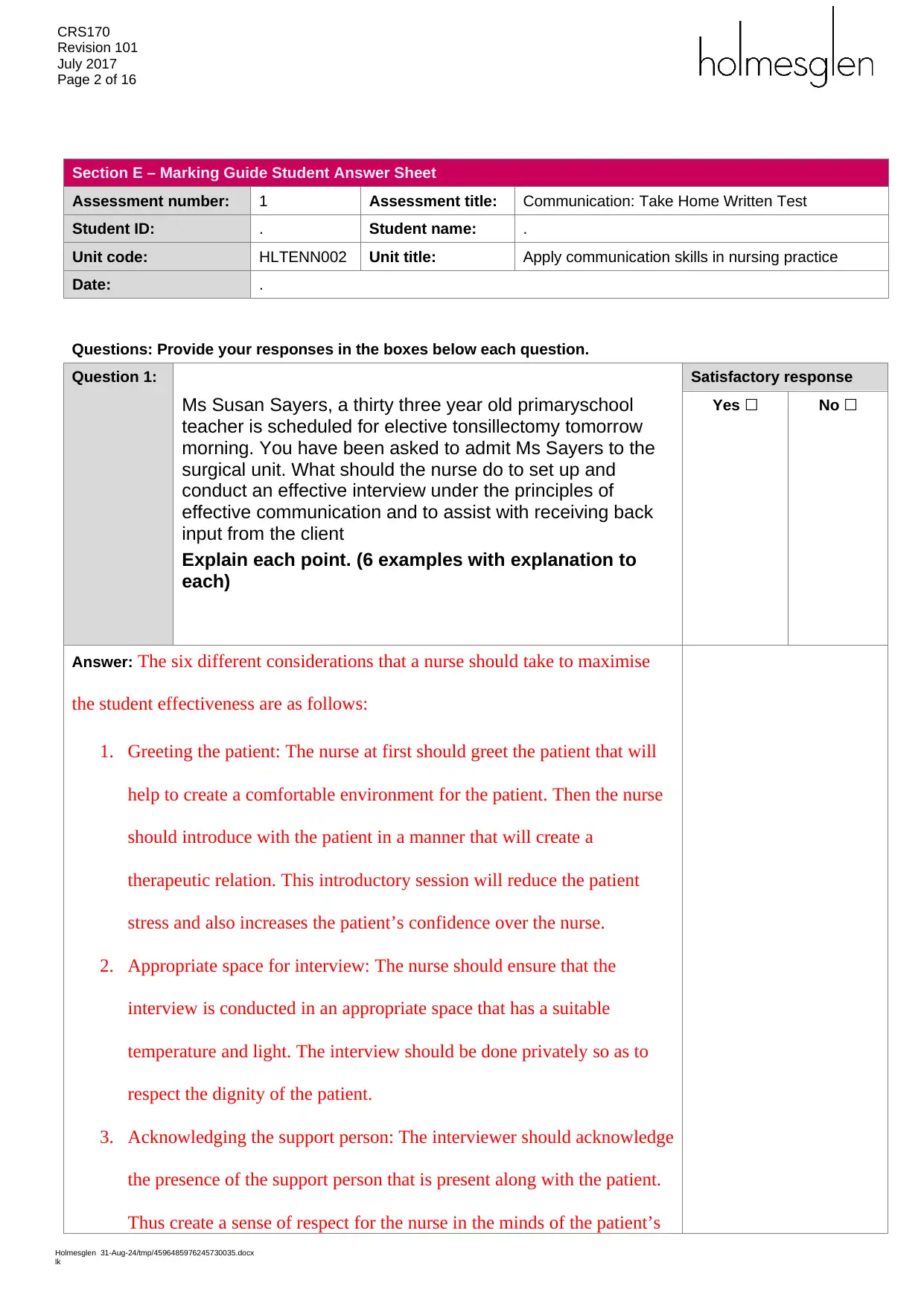
CRS170
Revision 101
July 2017
Page 2 of 16
Section E – Marking Guide Student Answer Sheet
Assessment number: 1 Assessment title: Communication: Take Home Written Test
Student ID: . Student name: .
Unit code: HLTENN002 Unit title: Apply communication skills in nursing practice
Date: .
Questions: Provide your responses in the boxes below each question.
Question 1:
Ms Susan Sayers, a thirty three year old primaryschool
teacher is scheduled for elective tonsillectomy tomorrow
morning. You have been asked to admit Ms Sayers to the
surgical unit. What should the nurse do to set up and
conduct an effective interview under the principles of
effective communication and to assist with receiving back
input from the client
Explain each point. (6 examples with explanation to
each)
Satisfactory response
Yes ☐ No ☐
Answer: The six different considerations that a nurse should take to maximise
the student effectiveness are as follows:
1. Greeting the patient: The nurse at first should greet the patient that will
help to create a comfortable environment for the patient. Then the nurse
should introduce with the patient in a manner that will create a
therapeutic relation. This introductory session will reduce the patient
stress and also increases the patient’s confidence over the nurse.
2. Appropriate space for interview: The nurse should ensure that the
interview is conducted in an appropriate space that has a suitable
temperature and light. The interview should be done privately so as to
respect the dignity of the patient.
3. Acknowledging the support person: The interviewer should acknowledge
the presence of the support person that is present along with the patient.
Thus create a sense of respect for the nurse in the minds of the patient’s
Holmesglen 31-Aug-24/tmp/4596485976245730035.docx
lk
Revision 101
July 2017
Page 2 of 16
Section E – Marking Guide Student Answer Sheet
Assessment number: 1 Assessment title: Communication: Take Home Written Test
Student ID: . Student name: .
Unit code: HLTENN002 Unit title: Apply communication skills in nursing practice
Date: .
Questions: Provide your responses in the boxes below each question.
Question 1:
Ms Susan Sayers, a thirty three year old primaryschool
teacher is scheduled for elective tonsillectomy tomorrow
morning. You have been asked to admit Ms Sayers to the
surgical unit. What should the nurse do to set up and
conduct an effective interview under the principles of
effective communication and to assist with receiving back
input from the client
Explain each point. (6 examples with explanation to
each)
Satisfactory response
Yes ☐ No ☐
Answer: The six different considerations that a nurse should take to maximise
the student effectiveness are as follows:
1. Greeting the patient: The nurse at first should greet the patient that will
help to create a comfortable environment for the patient. Then the nurse
should introduce with the patient in a manner that will create a
therapeutic relation. This introductory session will reduce the patient
stress and also increases the patient’s confidence over the nurse.
2. Appropriate space for interview: The nurse should ensure that the
interview is conducted in an appropriate space that has a suitable
temperature and light. The interview should be done privately so as to
respect the dignity of the patient.
3. Acknowledging the support person: The interviewer should acknowledge
the presence of the support person that is present along with the patient.
Thus create a sense of respect for the nurse in the minds of the patient’s
Holmesglen 31-Aug-24/tmp/4596485976245730035.docx
lk
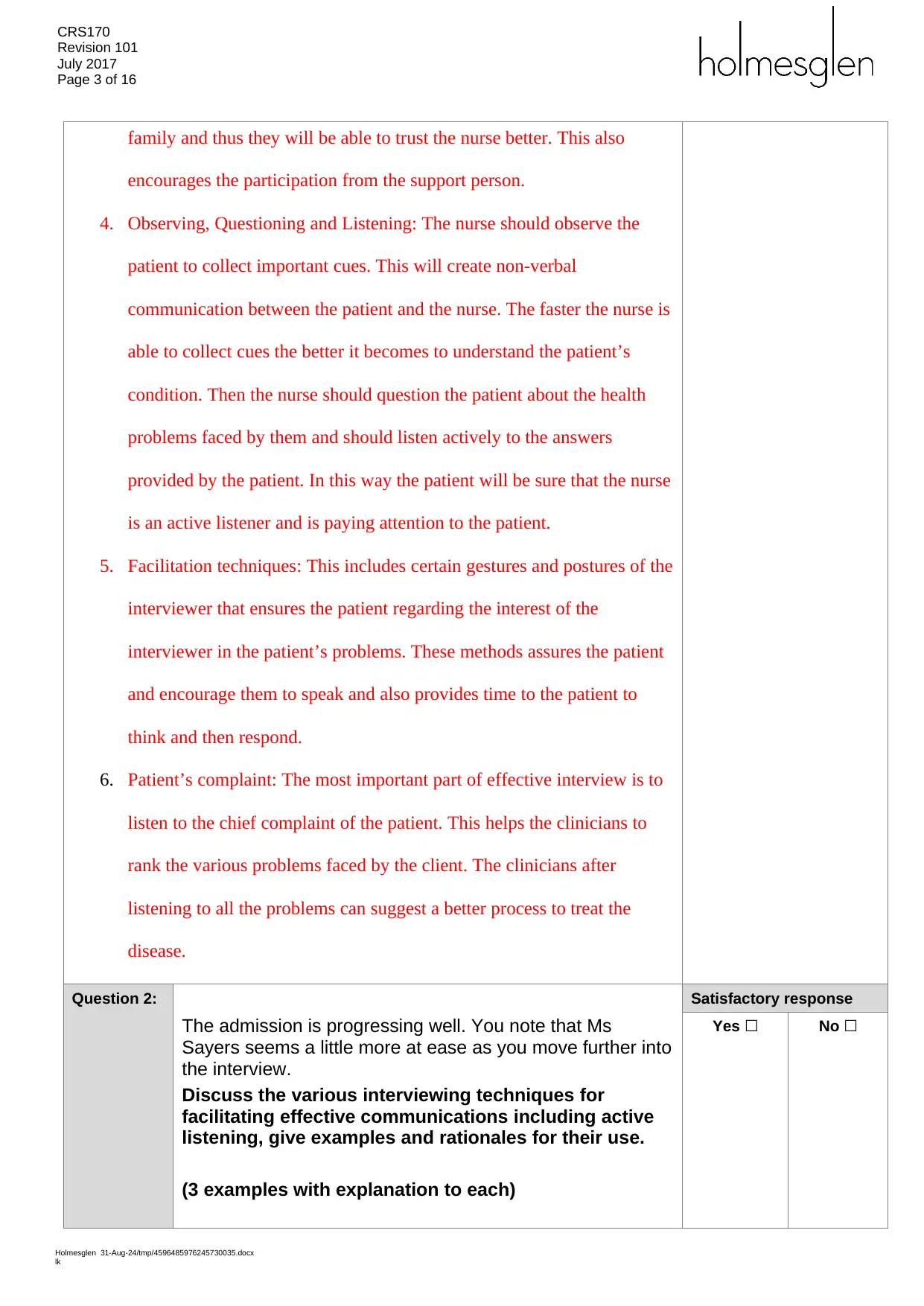
CRS170
Revision 101
July 2017
Page 3 of 16
family and thus they will be able to trust the nurse better. This also
encourages the participation from the support person.
4. Observing, Questioning and Listening: The nurse should observe the
patient to collect important cues. This will create non-verbal
communication between the patient and the nurse. The faster the nurse is
able to collect cues the better it becomes to understand the patient’s
condition. Then the nurse should question the patient about the health
problems faced by them and should listen actively to the answers
provided by the patient. In this way the patient will be sure that the nurse
is an active listener and is paying attention to the patient.
5. Facilitation techniques: This includes certain gestures and postures of the
interviewer that ensures the patient regarding the interest of the
interviewer in the patient’s problems. These methods assures the patient
and encourage them to speak and also provides time to the patient to
think and then respond.
6. Patient’s complaint: The most important part of effective interview is to
listen to the chief complaint of the patient. This helps the clinicians to
rank the various problems faced by the client. The clinicians after
listening to all the problems can suggest a better process to treat the
disease.
Question 2:
The admission is progressing well. You note that Ms
Sayers seems a little more at ease as you move further into
the interview.
Discuss the various interviewing techniques for
facilitating effective communications including active
listening, give examples and rationales for their use.
(3 examples with explanation to each)
Satisfactory response
Yes ☐ No ☐
Holmesglen 31-Aug-24/tmp/4596485976245730035.docx
lk
Revision 101
July 2017
Page 3 of 16
family and thus they will be able to trust the nurse better. This also
encourages the participation from the support person.
4. Observing, Questioning and Listening: The nurse should observe the
patient to collect important cues. This will create non-verbal
communication between the patient and the nurse. The faster the nurse is
able to collect cues the better it becomes to understand the patient’s
condition. Then the nurse should question the patient about the health
problems faced by them and should listen actively to the answers
provided by the patient. In this way the patient will be sure that the nurse
is an active listener and is paying attention to the patient.
5. Facilitation techniques: This includes certain gestures and postures of the
interviewer that ensures the patient regarding the interest of the
interviewer in the patient’s problems. These methods assures the patient
and encourage them to speak and also provides time to the patient to
think and then respond.
6. Patient’s complaint: The most important part of effective interview is to
listen to the chief complaint of the patient. This helps the clinicians to
rank the various problems faced by the client. The clinicians after
listening to all the problems can suggest a better process to treat the
disease.
Question 2:
The admission is progressing well. You note that Ms
Sayers seems a little more at ease as you move further into
the interview.
Discuss the various interviewing techniques for
facilitating effective communications including active
listening, give examples and rationales for their use.
(3 examples with explanation to each)
Satisfactory response
Yes ☐ No ☐
Holmesglen 31-Aug-24/tmp/4596485976245730035.docx
lk
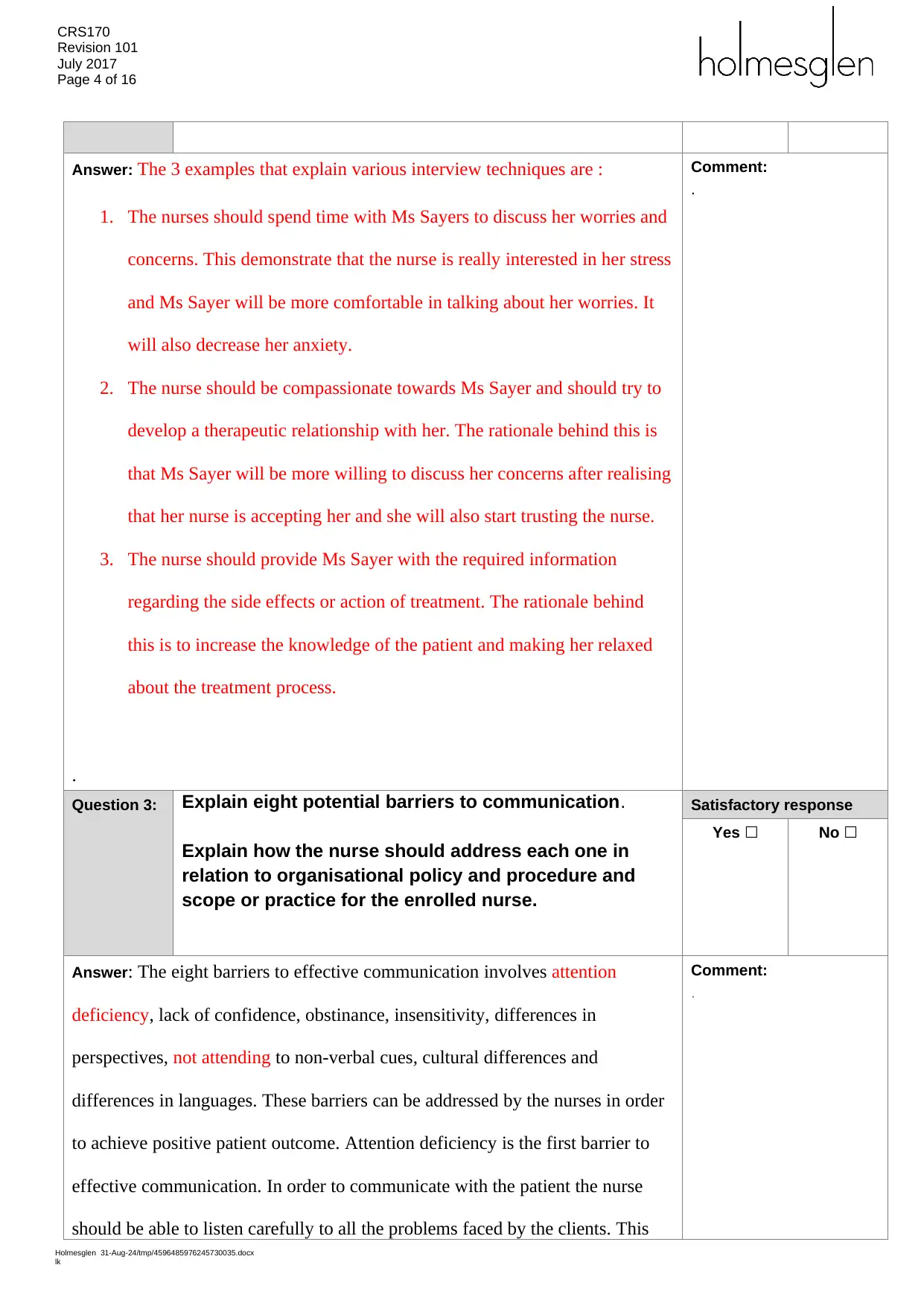
CRS170
Revision 101
July 2017
Page 4 of 16
Answer: The 3 examples that explain various interview techniques are :
1. The nurses should spend time with Ms Sayers to discuss her worries and
concerns. This demonstrate that the nurse is really interested in her stress
and Ms Sayer will be more comfortable in talking about her worries. It
will also decrease her anxiety.
2. The nurse should be compassionate towards Ms Sayer and should try to
develop a therapeutic relationship with her. The rationale behind this is
that Ms Sayer will be more willing to discuss her concerns after realising
that her nurse is accepting her and she will also start trusting the nurse.
3. The nurse should provide Ms Sayer with the required information
regarding the side effects or action of treatment. The rationale behind
this is to increase the knowledge of the patient and making her relaxed
about the treatment process.
.
Comment:
.
Question 3: Explain eight potential barriers to communication.
Explain how the nurse should address each one in
relation to organisational policy and procedure and
scope or practice for the enrolled nurse.
Satisfactory response
Yes ☐ No ☐
Answer: The eight barriers to effective communication involves attention
deficiency, lack of confidence, obstinance, insensitivity, differences in
perspectives, not attending to non-verbal cues, cultural differences and
differences in languages. These barriers can be addressed by the nurses in order
to achieve positive patient outcome. Attention deficiency is the first barrier to
effective communication. In order to communicate with the patient the nurse
should be able to listen carefully to all the problems faced by the clients. This
Comment:
.
Holmesglen 31-Aug-24/tmp/4596485976245730035.docx
lk
Revision 101
July 2017
Page 4 of 16
Answer: The 3 examples that explain various interview techniques are :
1. The nurses should spend time with Ms Sayers to discuss her worries and
concerns. This demonstrate that the nurse is really interested in her stress
and Ms Sayer will be more comfortable in talking about her worries. It
will also decrease her anxiety.
2. The nurse should be compassionate towards Ms Sayer and should try to
develop a therapeutic relationship with her. The rationale behind this is
that Ms Sayer will be more willing to discuss her concerns after realising
that her nurse is accepting her and she will also start trusting the nurse.
3. The nurse should provide Ms Sayer with the required information
regarding the side effects or action of treatment. The rationale behind
this is to increase the knowledge of the patient and making her relaxed
about the treatment process.
.
Comment:
.
Question 3: Explain eight potential barriers to communication.
Explain how the nurse should address each one in
relation to organisational policy and procedure and
scope or practice for the enrolled nurse.
Satisfactory response
Yes ☐ No ☐
Answer: The eight barriers to effective communication involves attention
deficiency, lack of confidence, obstinance, insensitivity, differences in
perspectives, not attending to non-verbal cues, cultural differences and
differences in languages. These barriers can be addressed by the nurses in order
to achieve positive patient outcome. Attention deficiency is the first barrier to
effective communication. In order to communicate with the patient the nurse
should be able to listen carefully to all the problems faced by the clients. This
Comment:
.
Holmesglen 31-Aug-24/tmp/4596485976245730035.docx
lk
Secure Best Marks with AI Grader
Need help grading? Try our AI Grader for instant feedback on your assignments.
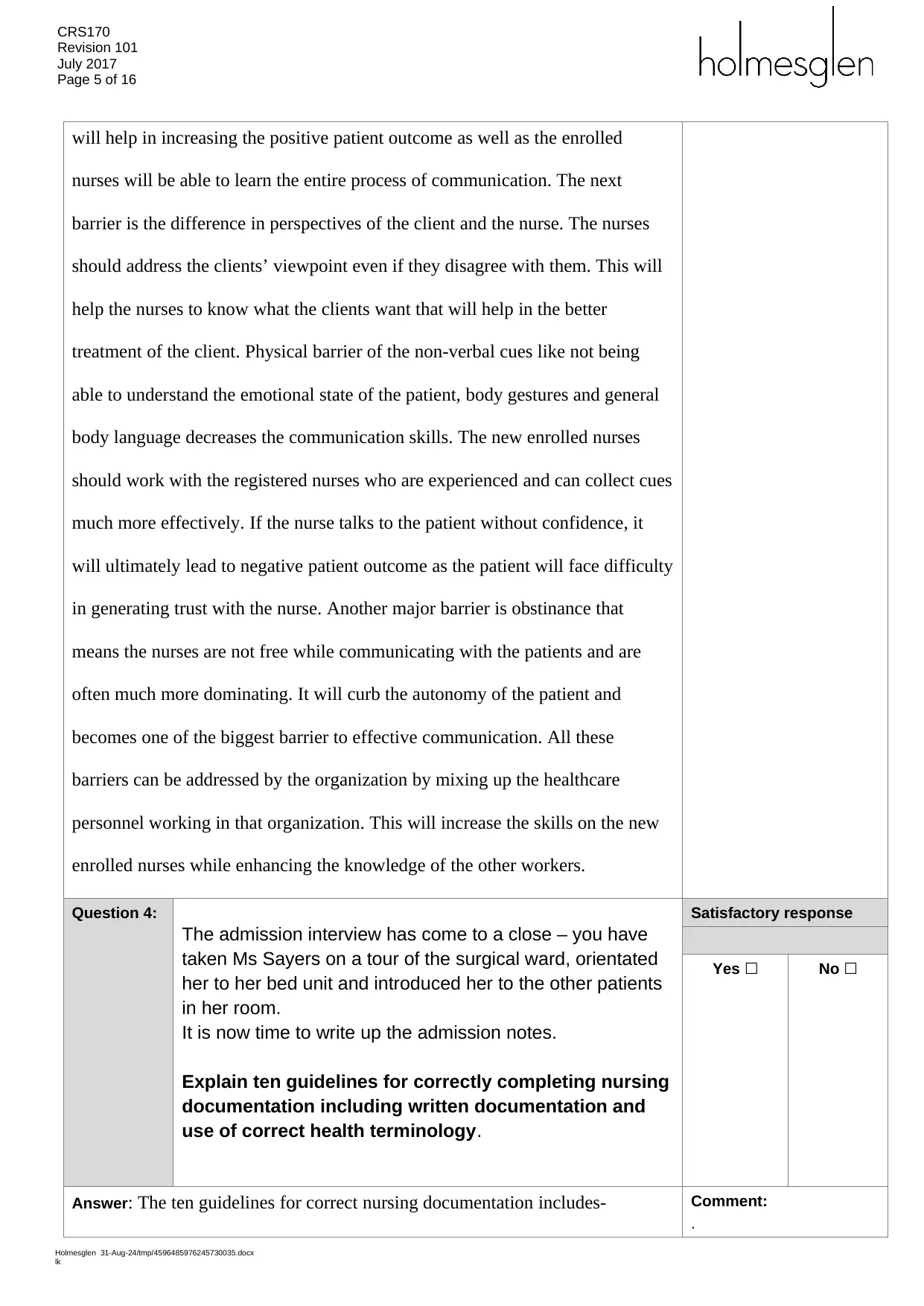
CRS170
Revision 101
July 2017
Page 5 of 16
will help in increasing the positive patient outcome as well as the enrolled
nurses will be able to learn the entire process of communication. The next
barrier is the difference in perspectives of the client and the nurse. The nurses
should address the clients’ viewpoint even if they disagree with them. This will
help the nurses to know what the clients want that will help in the better
treatment of the client. Physical barrier of the non-verbal cues like not being
able to understand the emotional state of the patient, body gestures and general
body language decreases the communication skills. The new enrolled nurses
should work with the registered nurses who are experienced and can collect cues
much more effectively. If the nurse talks to the patient without confidence, it
will ultimately lead to negative patient outcome as the patient will face difficulty
in generating trust with the nurse. Another major barrier is obstinance that
means the nurses are not free while communicating with the patients and are
often much more dominating. It will curb the autonomy of the patient and
becomes one of the biggest barrier to effective communication. All these
barriers can be addressed by the organization by mixing up the healthcare
personnel working in that organization. This will increase the skills on the new
enrolled nurses while enhancing the knowledge of the other workers.
Question 4:
The admission interview has come to a close – you have
taken Ms Sayers on a tour of the surgical ward, orientated
her to her bed unit and introduced her to the other patients
in her room.
It is now time to write up the admission notes.
Explain ten guidelines for correctly completing nursing
documentation including written documentation and
use of correct health terminology.
Satisfactory response
Yes ☐ No ☐
Answer: The ten guidelines for correct nursing documentation includes- Comment:
.
Holmesglen 31-Aug-24/tmp/4596485976245730035.docx
lk
Revision 101
July 2017
Page 5 of 16
will help in increasing the positive patient outcome as well as the enrolled
nurses will be able to learn the entire process of communication. The next
barrier is the difference in perspectives of the client and the nurse. The nurses
should address the clients’ viewpoint even if they disagree with them. This will
help the nurses to know what the clients want that will help in the better
treatment of the client. Physical barrier of the non-verbal cues like not being
able to understand the emotional state of the patient, body gestures and general
body language decreases the communication skills. The new enrolled nurses
should work with the registered nurses who are experienced and can collect cues
much more effectively. If the nurse talks to the patient without confidence, it
will ultimately lead to negative patient outcome as the patient will face difficulty
in generating trust with the nurse. Another major barrier is obstinance that
means the nurses are not free while communicating with the patients and are
often much more dominating. It will curb the autonomy of the patient and
becomes one of the biggest barrier to effective communication. All these
barriers can be addressed by the organization by mixing up the healthcare
personnel working in that organization. This will increase the skills on the new
enrolled nurses while enhancing the knowledge of the other workers.
Question 4:
The admission interview has come to a close – you have
taken Ms Sayers on a tour of the surgical ward, orientated
her to her bed unit and introduced her to the other patients
in her room.
It is now time to write up the admission notes.
Explain ten guidelines for correctly completing nursing
documentation including written documentation and
use of correct health terminology.
Satisfactory response
Yes ☐ No ☐
Answer: The ten guidelines for correct nursing documentation includes- Comment:
.
Holmesglen 31-Aug-24/tmp/4596485976245730035.docx
lk
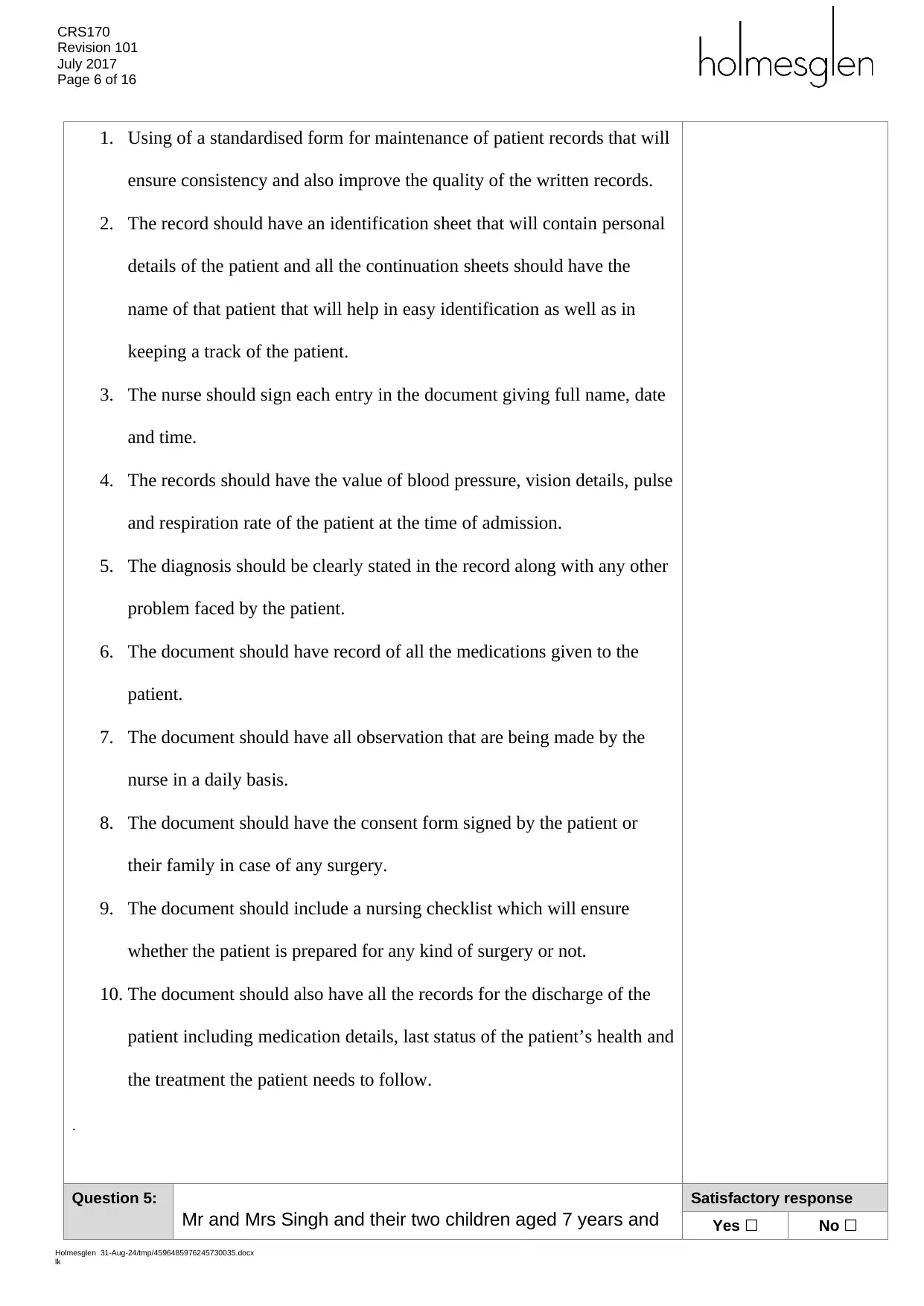
CRS170
Revision 101
July 2017
Page 6 of 16
1. Using of a standardised form for maintenance of patient records that will
ensure consistency and also improve the quality of the written records.
2. The record should have an identification sheet that will contain personal
details of the patient and all the continuation sheets should have the
name of that patient that will help in easy identification as well as in
keeping a track of the patient.
3. The nurse should sign each entry in the document giving full name, date
and time.
4. The records should have the value of blood pressure, vision details, pulse
and respiration rate of the patient at the time of admission.
5. The diagnosis should be clearly stated in the record along with any other
problem faced by the patient.
6. The document should have record of all the medications given to the
patient.
7. The document should have all observation that are being made by the
nurse in a daily basis.
8. The document should have the consent form signed by the patient or
their family in case of any surgery.
9. The document should include a nursing checklist which will ensure
whether the patient is prepared for any kind of surgery or not.
10. The document should also have all the records for the discharge of the
patient including medication details, last status of the patient’s health and
the treatment the patient needs to follow.
.
Question 5:
Mr and Mrs Singh and their two children aged 7 years and
Satisfactory response
Yes ☐ No ☐
Holmesglen 31-Aug-24/tmp/4596485976245730035.docx
lk
Revision 101
July 2017
Page 6 of 16
1. Using of a standardised form for maintenance of patient records that will
ensure consistency and also improve the quality of the written records.
2. The record should have an identification sheet that will contain personal
details of the patient and all the continuation sheets should have the
name of that patient that will help in easy identification as well as in
keeping a track of the patient.
3. The nurse should sign each entry in the document giving full name, date
and time.
4. The records should have the value of blood pressure, vision details, pulse
and respiration rate of the patient at the time of admission.
5. The diagnosis should be clearly stated in the record along with any other
problem faced by the patient.
6. The document should have record of all the medications given to the
patient.
7. The document should have all observation that are being made by the
nurse in a daily basis.
8. The document should have the consent form signed by the patient or
their family in case of any surgery.
9. The document should include a nursing checklist which will ensure
whether the patient is prepared for any kind of surgery or not.
10. The document should also have all the records for the discharge of the
patient including medication details, last status of the patient’s health and
the treatment the patient needs to follow.
.
Question 5:
Mr and Mrs Singh and their two children aged 7 years and
Satisfactory response
Yes ☐ No ☐
Holmesglen 31-Aug-24/tmp/4596485976245730035.docx
lk
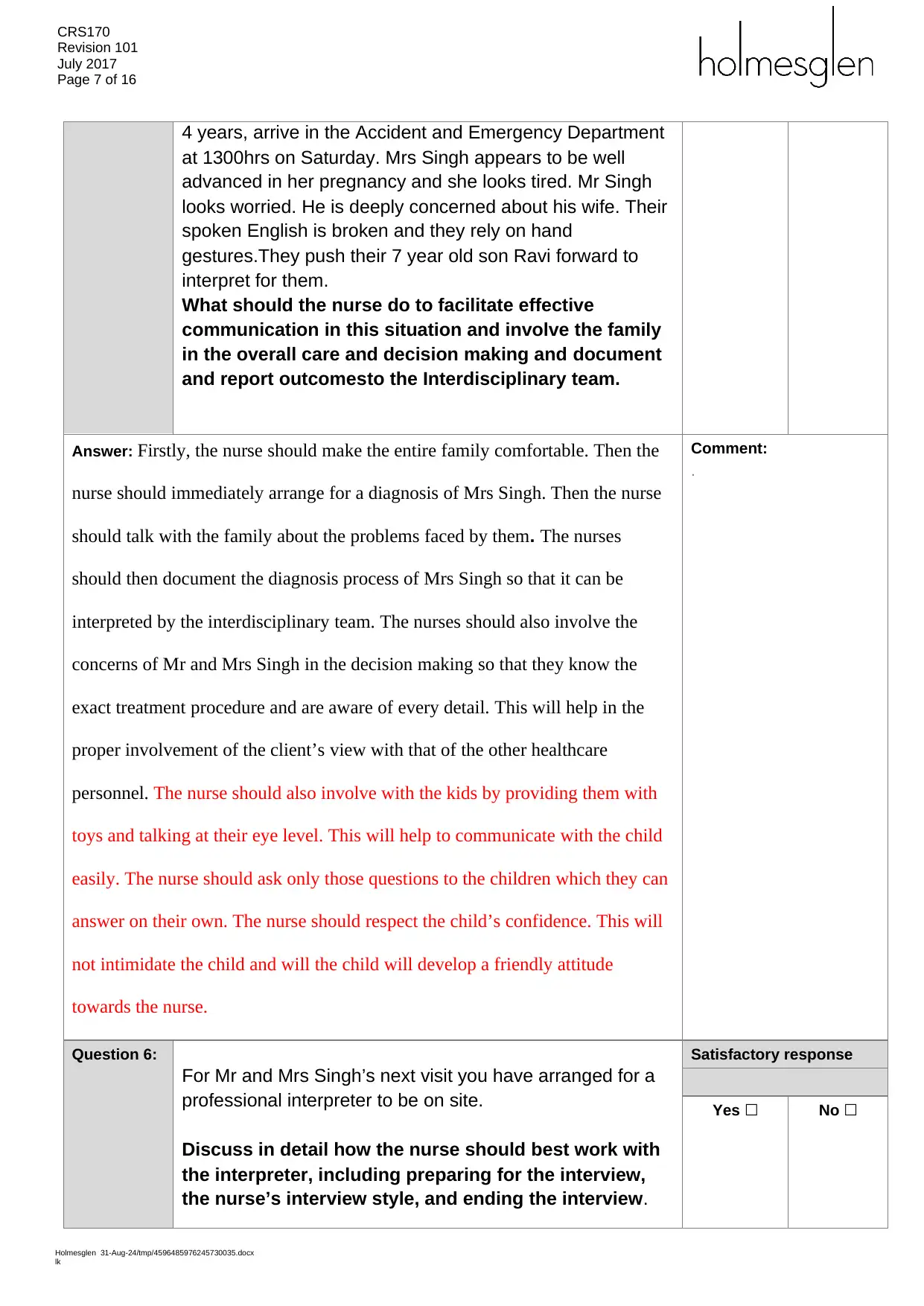
CRS170
Revision 101
July 2017
Page 7 of 16
4 years, arrive in the Accident and Emergency Department
at 1300hrs on Saturday. Mrs Singh appears to be well
advanced in her pregnancy and she looks tired. Mr Singh
looks worried. He is deeply concerned about his wife. Their
spoken English is broken and they rely on hand
gestures.They push their 7 year old son Ravi forward to
interpret for them.
What should the nurse do to facilitate effective
communication in this situation and involve the family
in the overall care and decision making and document
and report outcomesto the Interdisciplinary team.
Answer: Firstly, the nurse should make the entire family comfortable. Then the
nurse should immediately arrange for a diagnosis of Mrs Singh. Then the nurse
should talk with the family about the problems faced by them. The nurses
should then document the diagnosis process of Mrs Singh so that it can be
interpreted by the interdisciplinary team. The nurses should also involve the
concerns of Mr and Mrs Singh in the decision making so that they know the
exact treatment procedure and are aware of every detail. This will help in the
proper involvement of the client’s view with that of the other healthcare
personnel. The nurse should also involve with the kids by providing them with
toys and talking at their eye level. This will help to communicate with the child
easily. The nurse should ask only those questions to the children which they can
answer on their own. The nurse should respect the child’s confidence. This will
not intimidate the child and will the child will develop a friendly attitude
towards the nurse.
Comment:
.
Question 6:
For Mr and Mrs Singh’s next visit you have arranged for a
professional interpreter to be on site.
Discuss in detail how the nurse should best work with
the interpreter, including preparing for the interview,
the nurse’s interview style, and ending the interview.
Satisfactory response
Yes ☐ No ☐
Holmesglen 31-Aug-24/tmp/4596485976245730035.docx
lk
Revision 101
July 2017
Page 7 of 16
4 years, arrive in the Accident and Emergency Department
at 1300hrs on Saturday. Mrs Singh appears to be well
advanced in her pregnancy and she looks tired. Mr Singh
looks worried. He is deeply concerned about his wife. Their
spoken English is broken and they rely on hand
gestures.They push their 7 year old son Ravi forward to
interpret for them.
What should the nurse do to facilitate effective
communication in this situation and involve the family
in the overall care and decision making and document
and report outcomesto the Interdisciplinary team.
Answer: Firstly, the nurse should make the entire family comfortable. Then the
nurse should immediately arrange for a diagnosis of Mrs Singh. Then the nurse
should talk with the family about the problems faced by them. The nurses
should then document the diagnosis process of Mrs Singh so that it can be
interpreted by the interdisciplinary team. The nurses should also involve the
concerns of Mr and Mrs Singh in the decision making so that they know the
exact treatment procedure and are aware of every detail. This will help in the
proper involvement of the client’s view with that of the other healthcare
personnel. The nurse should also involve with the kids by providing them with
toys and talking at their eye level. This will help to communicate with the child
easily. The nurse should ask only those questions to the children which they can
answer on their own. The nurse should respect the child’s confidence. This will
not intimidate the child and will the child will develop a friendly attitude
towards the nurse.
Comment:
.
Question 6:
For Mr and Mrs Singh’s next visit you have arranged for a
professional interpreter to be on site.
Discuss in detail how the nurse should best work with
the interpreter, including preparing for the interview,
the nurse’s interview style, and ending the interview.
Satisfactory response
Yes ☐ No ☐
Holmesglen 31-Aug-24/tmp/4596485976245730035.docx
lk
Paraphrase This Document
Need a fresh take? Get an instant paraphrase of this document with our AI Paraphraser
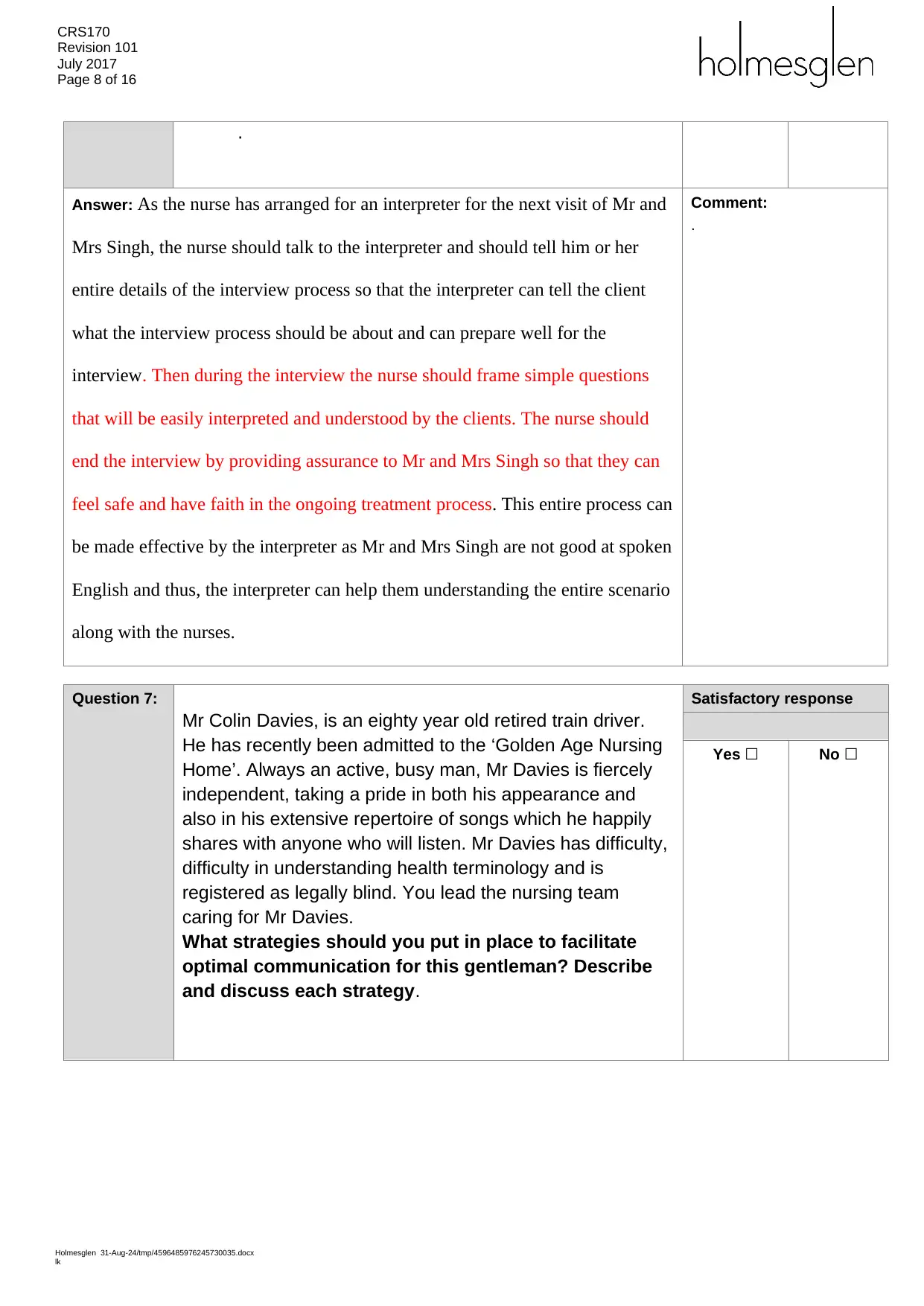
CRS170
Revision 101
July 2017
Page 8 of 16
.
Answer: As the nurse has arranged for an interpreter for the next visit of Mr and
Mrs Singh, the nurse should talk to the interpreter and should tell him or her
entire details of the interview process so that the interpreter can tell the client
what the interview process should be about and can prepare well for the
interview. Then during the interview the nurse should frame simple questions
that will be easily interpreted and understood by the clients. The nurse should
end the interview by providing assurance to Mr and Mrs Singh so that they can
feel safe and have faith in the ongoing treatment process. This entire process can
be made effective by the interpreter as Mr and Mrs Singh are not good at spoken
English and thus, the interpreter can help them understanding the entire scenario
along with the nurses.
Comment:
.
Question 7:
Mr Colin Davies, is an eighty year old retired train driver.
He has recently been admitted to the ‘Golden Age Nursing
Home’. Always an active, busy man, Mr Davies is fiercely
independent, taking a pride in both his appearance and
also in his extensive repertoire of songs which he happily
shares with anyone who will listen. Mr Davies has difficulty,
difficulty in understanding health terminology and is
registered as legally blind. You lead the nursing team
caring for Mr Davies.
What strategies should you put in place to facilitate
optimal communication for this gentleman? Describe
and discuss each strategy.
Satisfactory response
Yes ☐ No ☐
Holmesglen 31-Aug-24/tmp/4596485976245730035.docx
lk
Revision 101
July 2017
Page 8 of 16
.
Answer: As the nurse has arranged for an interpreter for the next visit of Mr and
Mrs Singh, the nurse should talk to the interpreter and should tell him or her
entire details of the interview process so that the interpreter can tell the client
what the interview process should be about and can prepare well for the
interview. Then during the interview the nurse should frame simple questions
that will be easily interpreted and understood by the clients. The nurse should
end the interview by providing assurance to Mr and Mrs Singh so that they can
feel safe and have faith in the ongoing treatment process. This entire process can
be made effective by the interpreter as Mr and Mrs Singh are not good at spoken
English and thus, the interpreter can help them understanding the entire scenario
along with the nurses.
Comment:
.
Question 7:
Mr Colin Davies, is an eighty year old retired train driver.
He has recently been admitted to the ‘Golden Age Nursing
Home’. Always an active, busy man, Mr Davies is fiercely
independent, taking a pride in both his appearance and
also in his extensive repertoire of songs which he happily
shares with anyone who will listen. Mr Davies has difficulty,
difficulty in understanding health terminology and is
registered as legally blind. You lead the nursing team
caring for Mr Davies.
What strategies should you put in place to facilitate
optimal communication for this gentleman? Describe
and discuss each strategy.
Satisfactory response
Yes ☐ No ☐
Holmesglen 31-Aug-24/tmp/4596485976245730035.docx
lk
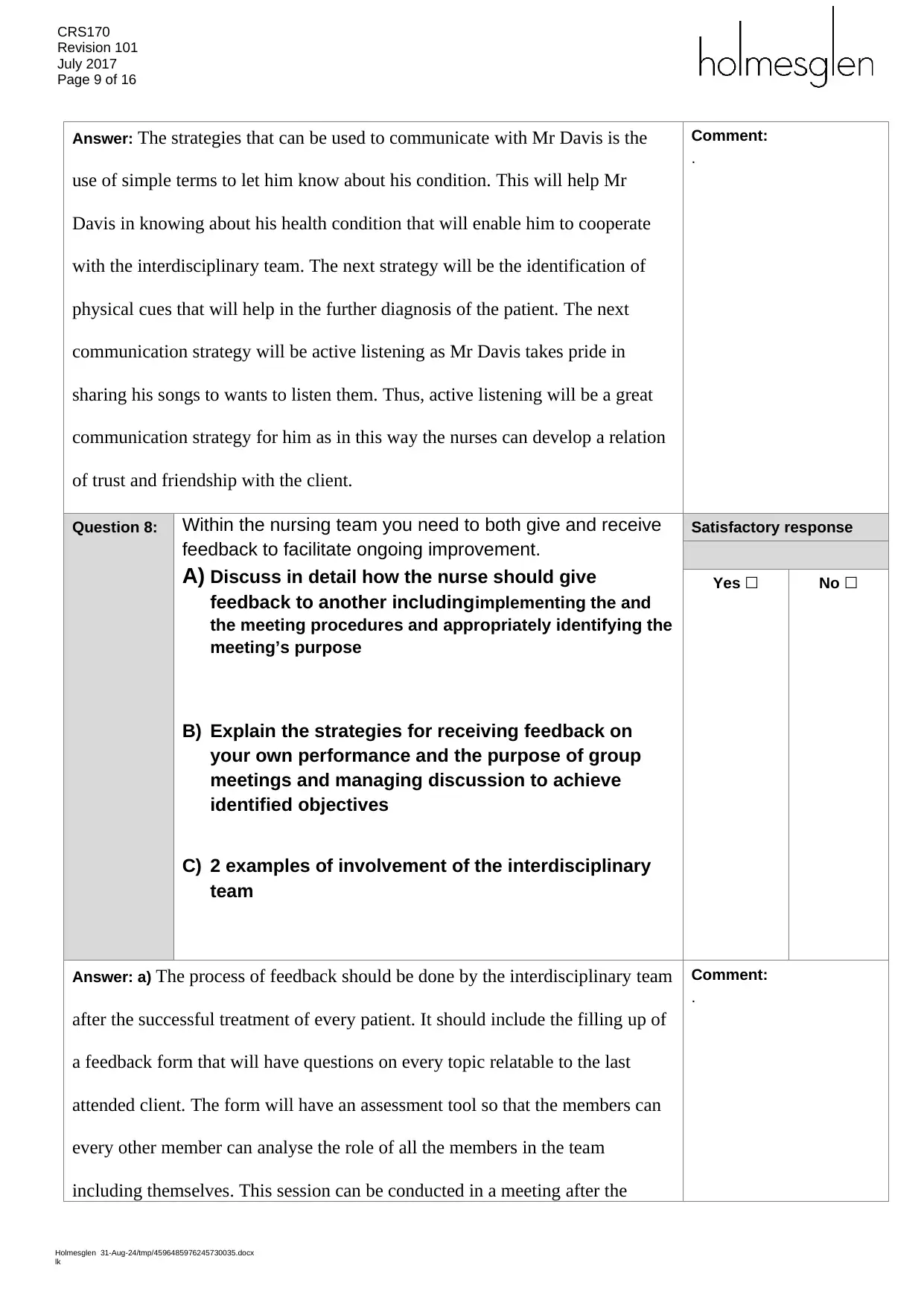
CRS170
Revision 101
July 2017
Page 9 of 16
Answer: The strategies that can be used to communicate with Mr Davis is the
use of simple terms to let him know about his condition. This will help Mr
Davis in knowing about his health condition that will enable him to cooperate
with the interdisciplinary team. The next strategy will be the identification of
physical cues that will help in the further diagnosis of the patient. The next
communication strategy will be active listening as Mr Davis takes pride in
sharing his songs to wants to listen them. Thus, active listening will be a great
communication strategy for him as in this way the nurses can develop a relation
of trust and friendship with the client.
Comment:
.
Question 8: Within the nursing team you need to both give and receive
feedback to facilitate ongoing improvement.
A) Discuss in detail how the nurse should give
feedback to another includingimplementing the and
the meeting procedures and appropriately identifying the
meeting’s purpose
B) Explain the strategies for receiving feedback on
your own performance and the purpose of group
meetings and managing discussion to achieve
identified objectives
C) 2 examples of involvement of the interdisciplinary
team
Satisfactory response
Yes ☐ No ☐
Answer: a) The process of feedback should be done by the interdisciplinary team
after the successful treatment of every patient. It should include the filling up of
a feedback form that will have questions on every topic relatable to the last
attended client. The form will have an assessment tool so that the members can
every other member can analyse the role of all the members in the team
including themselves. This session can be conducted in a meeting after the
Comment:
.
Holmesglen 31-Aug-24/tmp/4596485976245730035.docx
lk
Revision 101
July 2017
Page 9 of 16
Answer: The strategies that can be used to communicate with Mr Davis is the
use of simple terms to let him know about his condition. This will help Mr
Davis in knowing about his health condition that will enable him to cooperate
with the interdisciplinary team. The next strategy will be the identification of
physical cues that will help in the further diagnosis of the patient. The next
communication strategy will be active listening as Mr Davis takes pride in
sharing his songs to wants to listen them. Thus, active listening will be a great
communication strategy for him as in this way the nurses can develop a relation
of trust and friendship with the client.
Comment:
.
Question 8: Within the nursing team you need to both give and receive
feedback to facilitate ongoing improvement.
A) Discuss in detail how the nurse should give
feedback to another includingimplementing the and
the meeting procedures and appropriately identifying the
meeting’s purpose
B) Explain the strategies for receiving feedback on
your own performance and the purpose of group
meetings and managing discussion to achieve
identified objectives
C) 2 examples of involvement of the interdisciplinary
team
Satisfactory response
Yes ☐ No ☐
Answer: a) The process of feedback should be done by the interdisciplinary team
after the successful treatment of every patient. It should include the filling up of
a feedback form that will have questions on every topic relatable to the last
attended client. The form will have an assessment tool so that the members can
every other member can analyse the role of all the members in the team
including themselves. This session can be conducted in a meeting after the
Comment:
.
Holmesglen 31-Aug-24/tmp/4596485976245730035.docx
lk

CRS170
Revision 101
July 2017
Page 10 of 16
discharge of the patient.
b) The feedback thus, received by all the members collectively assess the role of
that particular worker in the team. T will help in the improvement of the worker
as well as in the development of mutual understanding among the team
members. As these feedbacks are given in team meetings the sole purpose of the
meeting will be strengthening of the team bond and also to develop a single goal
of better patient outcome. These meetings will also generate discussions among
the members which is again a good step in an interdisciplinary team as it will
increase communication among the members.
c) The first example is the involvement of nurses, psychologists, speech
therapist, pharmacists, dieticians, physicians and nurse practitioners. This group
was involved in the collaborative model of inter-professional clinical teaching
and learning that was developed for an existing patient care unit. It aims to
influence patient care by giving support to the inter-professional environment
and also by creating a positive learning as well as practice environment for
academicians, students and front-line patient care teams.
The second example shows the involvement of a team that consists of nurses,
pharmacists, social works, community centre workers, medical technologists
and educators. They work together for the management, prevention, treatment
and care of patients affected with HIV/AIDS. The team assists the patients in
training as well as it helps in the gaining of knowledge and skills of the team
members.
Question 9:
Define ‘Open Disclosure’.
State the eight key elements of open disclosure and
explain the process.
Satisfactory response
Yes ☐ No ☐
Answer:Open disclosure is the discussion of a series of incidents that is going to Comment:
.
Holmesglen 31-Aug-24/tmp/4596485976245730035.docx
lk
Revision 101
July 2017
Page 10 of 16
discharge of the patient.
b) The feedback thus, received by all the members collectively assess the role of
that particular worker in the team. T will help in the improvement of the worker
as well as in the development of mutual understanding among the team
members. As these feedbacks are given in team meetings the sole purpose of the
meeting will be strengthening of the team bond and also to develop a single goal
of better patient outcome. These meetings will also generate discussions among
the members which is again a good step in an interdisciplinary team as it will
increase communication among the members.
c) The first example is the involvement of nurses, psychologists, speech
therapist, pharmacists, dieticians, physicians and nurse practitioners. This group
was involved in the collaborative model of inter-professional clinical teaching
and learning that was developed for an existing patient care unit. It aims to
influence patient care by giving support to the inter-professional environment
and also by creating a positive learning as well as practice environment for
academicians, students and front-line patient care teams.
The second example shows the involvement of a team that consists of nurses,
pharmacists, social works, community centre workers, medical technologists
and educators. They work together for the management, prevention, treatment
and care of patients affected with HIV/AIDS. The team assists the patients in
training as well as it helps in the gaining of knowledge and skills of the team
members.
Question 9:
Define ‘Open Disclosure’.
State the eight key elements of open disclosure and
explain the process.
Satisfactory response
Yes ☐ No ☐
Answer:Open disclosure is the discussion of a series of incidents that is going to Comment:
.
Holmesglen 31-Aug-24/tmp/4596485976245730035.docx
lk
Secure Best Marks with AI Grader
Need help grading? Try our AI Grader for instant feedback on your assignments.
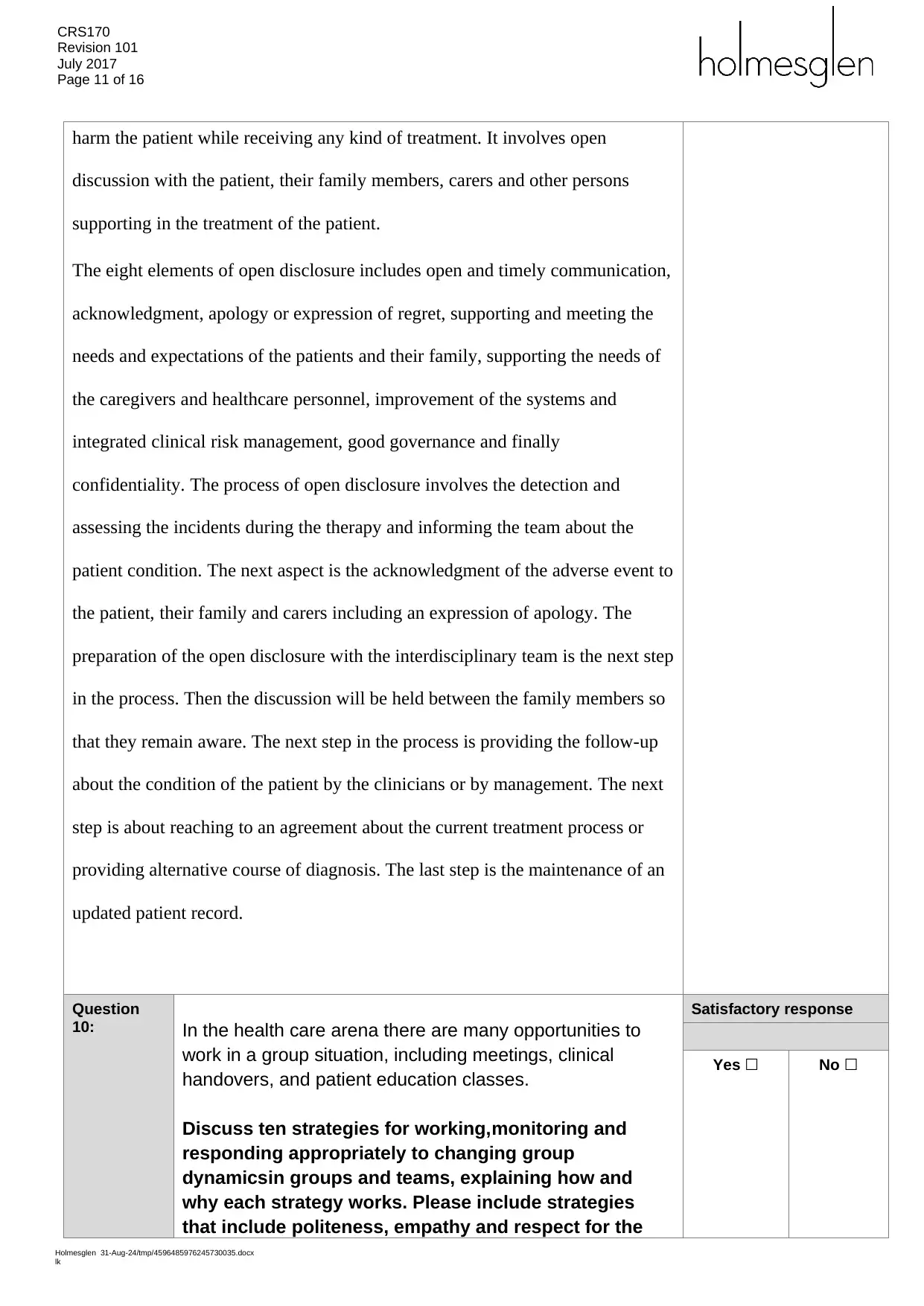
CRS170
Revision 101
July 2017
Page 11 of 16
harm the patient while receiving any kind of treatment. It involves open
discussion with the patient, their family members, carers and other persons
supporting in the treatment of the patient.
The eight elements of open disclosure includes open and timely communication,
acknowledgment, apology or expression of regret, supporting and meeting the
needs and expectations of the patients and their family, supporting the needs of
the caregivers and healthcare personnel, improvement of the systems and
integrated clinical risk management, good governance and finally
confidentiality. The process of open disclosure involves the detection and
assessing the incidents during the therapy and informing the team about the
patient condition. The next aspect is the acknowledgment of the adverse event to
the patient, their family and carers including an expression of apology. The
preparation of the open disclosure with the interdisciplinary team is the next step
in the process. Then the discussion will be held between the family members so
that they remain aware. The next step in the process is providing the follow-up
about the condition of the patient by the clinicians or by management. The next
step is about reaching to an agreement about the current treatment process or
providing alternative course of diagnosis. The last step is the maintenance of an
updated patient record.
Question
10: In the health care arena there are many opportunities to
work in a group situation, including meetings, clinical
handovers, and patient education classes.
Discuss ten strategies for working,monitoring and
responding appropriately to changing group
dynamicsin groups and teams, explaining how and
why each strategy works. Please include strategies
that include politeness, empathy and respect for the
Satisfactory response
Yes ☐ No ☐
Holmesglen 31-Aug-24/tmp/4596485976245730035.docx
lk
Revision 101
July 2017
Page 11 of 16
harm the patient while receiving any kind of treatment. It involves open
discussion with the patient, their family members, carers and other persons
supporting in the treatment of the patient.
The eight elements of open disclosure includes open and timely communication,
acknowledgment, apology or expression of regret, supporting and meeting the
needs and expectations of the patients and their family, supporting the needs of
the caregivers and healthcare personnel, improvement of the systems and
integrated clinical risk management, good governance and finally
confidentiality. The process of open disclosure involves the detection and
assessing the incidents during the therapy and informing the team about the
patient condition. The next aspect is the acknowledgment of the adverse event to
the patient, their family and carers including an expression of apology. The
preparation of the open disclosure with the interdisciplinary team is the next step
in the process. Then the discussion will be held between the family members so
that they remain aware. The next step in the process is providing the follow-up
about the condition of the patient by the clinicians or by management. The next
step is about reaching to an agreement about the current treatment process or
providing alternative course of diagnosis. The last step is the maintenance of an
updated patient record.
Question
10: In the health care arena there are many opportunities to
work in a group situation, including meetings, clinical
handovers, and patient education classes.
Discuss ten strategies for working,monitoring and
responding appropriately to changing group
dynamicsin groups and teams, explaining how and
why each strategy works. Please include strategies
that include politeness, empathy and respect for the
Satisfactory response
Yes ☐ No ☐
Holmesglen 31-Aug-24/tmp/4596485976245730035.docx
lk
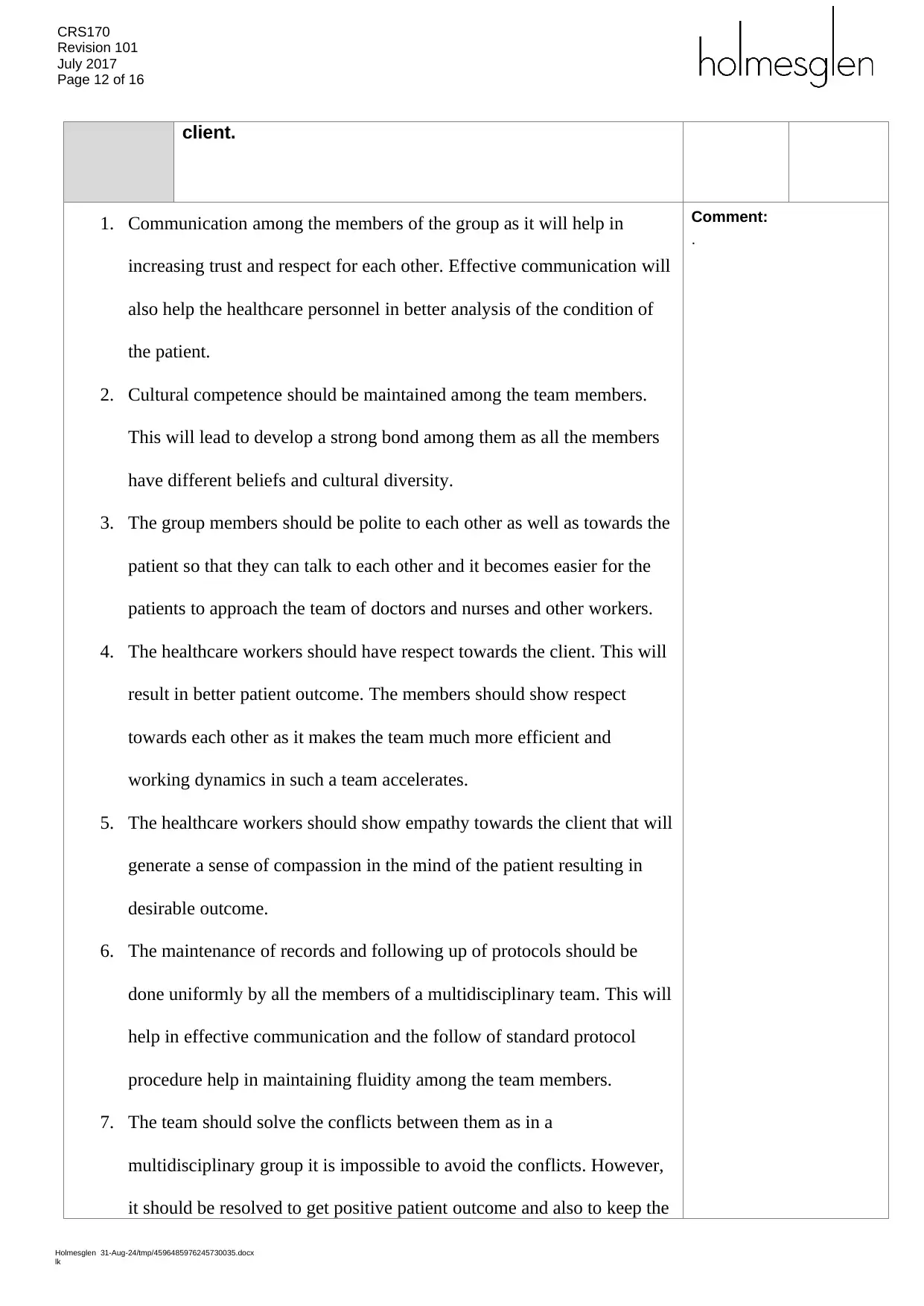
CRS170
Revision 101
July 2017
Page 12 of 16
client.
1. Communication among the members of the group as it will help in
increasing trust and respect for each other. Effective communication will
also help the healthcare personnel in better analysis of the condition of
the patient.
2. Cultural competence should be maintained among the team members.
This will lead to develop a strong bond among them as all the members
have different beliefs and cultural diversity.
3. The group members should be polite to each other as well as towards the
patient so that they can talk to each other and it becomes easier for the
patients to approach the team of doctors and nurses and other workers.
4. The healthcare workers should have respect towards the client. This will
result in better patient outcome. The members should show respect
towards each other as it makes the team much more efficient and
working dynamics in such a team accelerates.
5. The healthcare workers should show empathy towards the client that will
generate a sense of compassion in the mind of the patient resulting in
desirable outcome.
6. The maintenance of records and following up of protocols should be
done uniformly by all the members of a multidisciplinary team. This will
help in effective communication and the follow of standard protocol
procedure help in maintaining fluidity among the team members.
7. The team should solve the conflicts between them as in a
multidisciplinary group it is impossible to avoid the conflicts. However,
it should be resolved to get positive patient outcome and also to keep the
Comment:
.
Holmesglen 31-Aug-24/tmp/4596485976245730035.docx
lk
Revision 101
July 2017
Page 12 of 16
client.
1. Communication among the members of the group as it will help in
increasing trust and respect for each other. Effective communication will
also help the healthcare personnel in better analysis of the condition of
the patient.
2. Cultural competence should be maintained among the team members.
This will lead to develop a strong bond among them as all the members
have different beliefs and cultural diversity.
3. The group members should be polite to each other as well as towards the
patient so that they can talk to each other and it becomes easier for the
patients to approach the team of doctors and nurses and other workers.
4. The healthcare workers should have respect towards the client. This will
result in better patient outcome. The members should show respect
towards each other as it makes the team much more efficient and
working dynamics in such a team accelerates.
5. The healthcare workers should show empathy towards the client that will
generate a sense of compassion in the mind of the patient resulting in
desirable outcome.
6. The maintenance of records and following up of protocols should be
done uniformly by all the members of a multidisciplinary team. This will
help in effective communication and the follow of standard protocol
procedure help in maintaining fluidity among the team members.
7. The team should solve the conflicts between them as in a
multidisciplinary group it is impossible to avoid the conflicts. However,
it should be resolved to get positive patient outcome and also to keep the
Comment:
.
Holmesglen 31-Aug-24/tmp/4596485976245730035.docx
lk
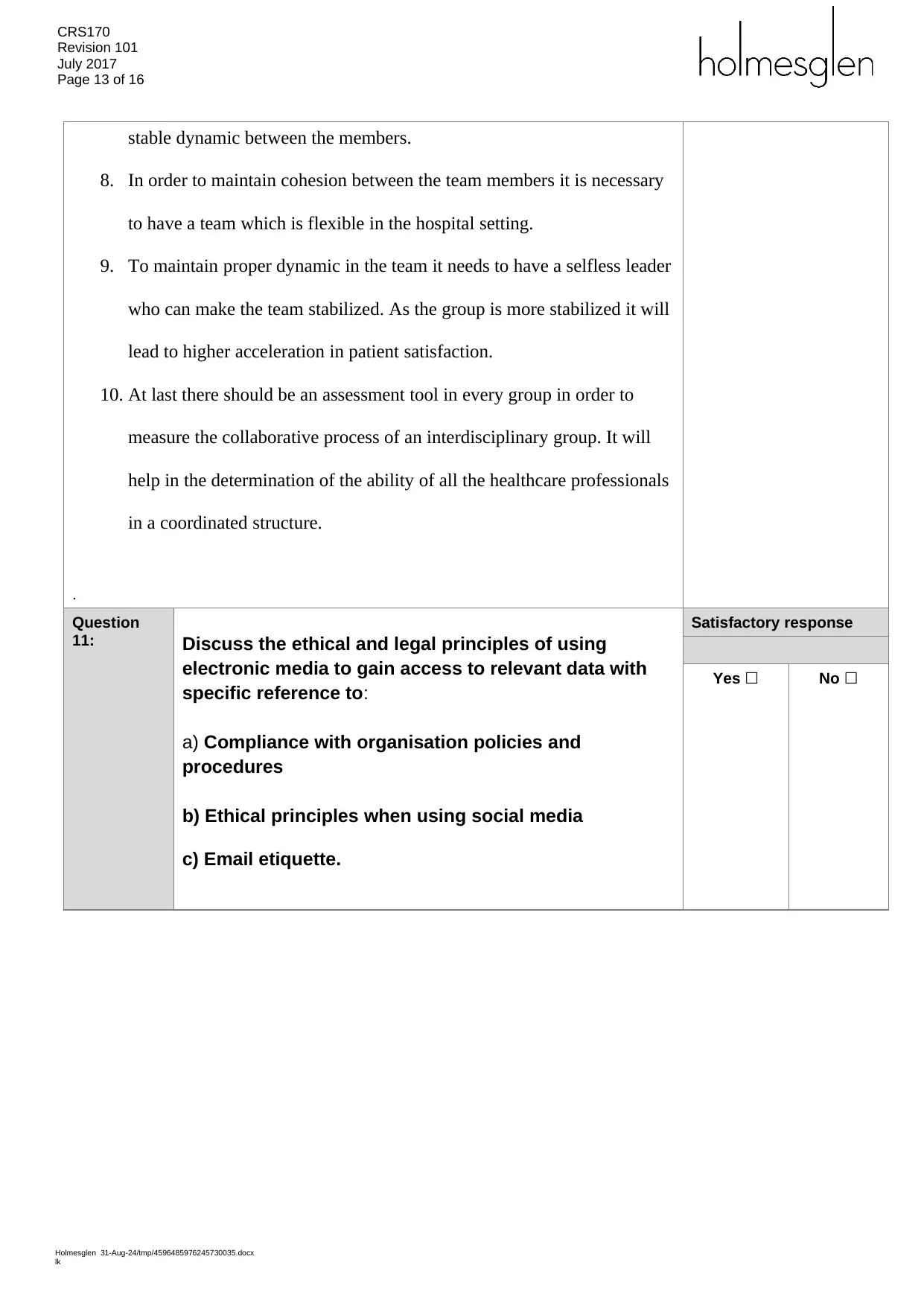
CRS170
Revision 101
July 2017
Page 13 of 16
stable dynamic between the members.
8. In order to maintain cohesion between the team members it is necessary
to have a team which is flexible in the hospital setting.
9. To maintain proper dynamic in the team it needs to have a selfless leader
who can make the team stabilized. As the group is more stabilized it will
lead to higher acceleration in patient satisfaction.
10. At last there should be an assessment tool in every group in order to
measure the collaborative process of an interdisciplinary group. It will
help in the determination of the ability of all the healthcare professionals
in a coordinated structure.
.
Question
11: Discuss the ethical and legal principles of using
electronic media to gain access to relevant data with
specific reference to:
a) Compliance with organisation policies and
procedures
b) Ethical principles when using social media
c) Email etiquette.
Satisfactory response
Yes ☐ No ☐
Holmesglen 31-Aug-24/tmp/4596485976245730035.docx
lk
Revision 101
July 2017
Page 13 of 16
stable dynamic between the members.
8. In order to maintain cohesion between the team members it is necessary
to have a team which is flexible in the hospital setting.
9. To maintain proper dynamic in the team it needs to have a selfless leader
who can make the team stabilized. As the group is more stabilized it will
lead to higher acceleration in patient satisfaction.
10. At last there should be an assessment tool in every group in order to
measure the collaborative process of an interdisciplinary group. It will
help in the determination of the ability of all the healthcare professionals
in a coordinated structure.
.
Question
11: Discuss the ethical and legal principles of using
electronic media to gain access to relevant data with
specific reference to:
a) Compliance with organisation policies and
procedures
b) Ethical principles when using social media
c) Email etiquette.
Satisfactory response
Yes ☐ No ☐
Holmesglen 31-Aug-24/tmp/4596485976245730035.docx
lk
Paraphrase This Document
Need a fresh take? Get an instant paraphrase of this document with our AI Paraphraser
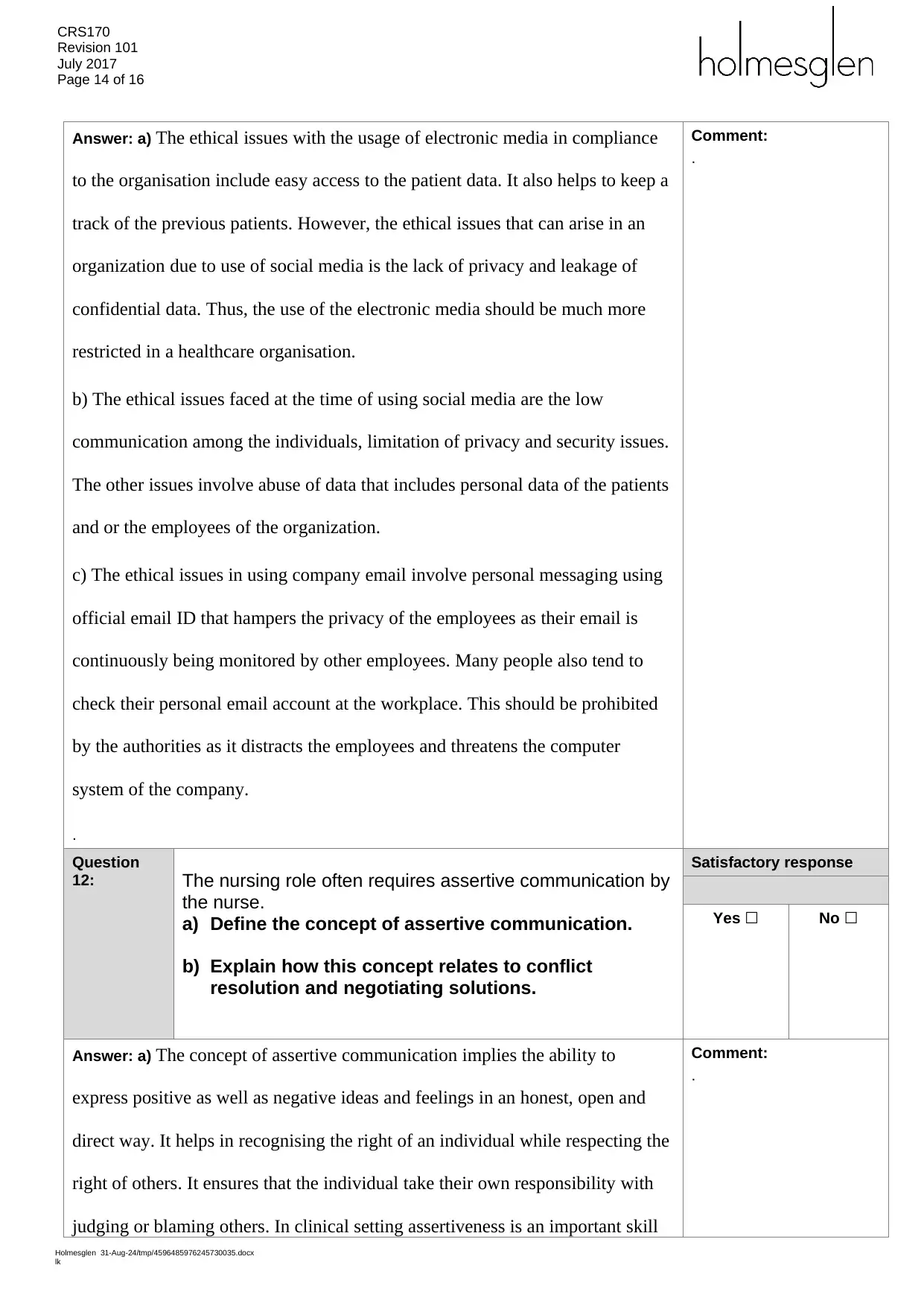
CRS170
Revision 101
July 2017
Page 14 of 16
Answer: a) The ethical issues with the usage of electronic media in compliance
to the organisation include easy access to the patient data. It also helps to keep a
track of the previous patients. However, the ethical issues that can arise in an
organization due to use of social media is the lack of privacy and leakage of
confidential data. Thus, the use of the electronic media should be much more
restricted in a healthcare organisation.
b) The ethical issues faced at the time of using social media are the low
communication among the individuals, limitation of privacy and security issues.
The other issues involve abuse of data that includes personal data of the patients
and or the employees of the organization.
c) The ethical issues in using company email involve personal messaging using
official email ID that hampers the privacy of the employees as their email is
continuously being monitored by other employees. Many people also tend to
check their personal email account at the workplace. This should be prohibited
by the authorities as it distracts the employees and threatens the computer
system of the company.
.
Comment:
.
Question
12: The nursing role often requires assertive communication by
the nurse.
a) Define the concept of assertive communication.
b) Explain how this concept relates to conflict
resolution and negotiating solutions.
Satisfactory response
Yes ☐ No ☐
Answer: a) The concept of assertive communication implies the ability to
express positive as well as negative ideas and feelings in an honest, open and
direct way. It helps in recognising the right of an individual while respecting the
right of others. It ensures that the individual take their own responsibility with
judging or blaming others. In clinical setting assertiveness is an important skill
Comment:
.
Holmesglen 31-Aug-24/tmp/4596485976245730035.docx
lk
Revision 101
July 2017
Page 14 of 16
Answer: a) The ethical issues with the usage of electronic media in compliance
to the organisation include easy access to the patient data. It also helps to keep a
track of the previous patients. However, the ethical issues that can arise in an
organization due to use of social media is the lack of privacy and leakage of
confidential data. Thus, the use of the electronic media should be much more
restricted in a healthcare organisation.
b) The ethical issues faced at the time of using social media are the low
communication among the individuals, limitation of privacy and security issues.
The other issues involve abuse of data that includes personal data of the patients
and or the employees of the organization.
c) The ethical issues in using company email involve personal messaging using
official email ID that hampers the privacy of the employees as their email is
continuously being monitored by other employees. Many people also tend to
check their personal email account at the workplace. This should be prohibited
by the authorities as it distracts the employees and threatens the computer
system of the company.
.
Comment:
.
Question
12: The nursing role often requires assertive communication by
the nurse.
a) Define the concept of assertive communication.
b) Explain how this concept relates to conflict
resolution and negotiating solutions.
Satisfactory response
Yes ☐ No ☐
Answer: a) The concept of assertive communication implies the ability to
express positive as well as negative ideas and feelings in an honest, open and
direct way. It helps in recognising the right of an individual while respecting the
right of others. It ensures that the individual take their own responsibility with
judging or blaming others. In clinical setting assertiveness is an important skill
Comment:
.
Holmesglen 31-Aug-24/tmp/4596485976245730035.docx
lk
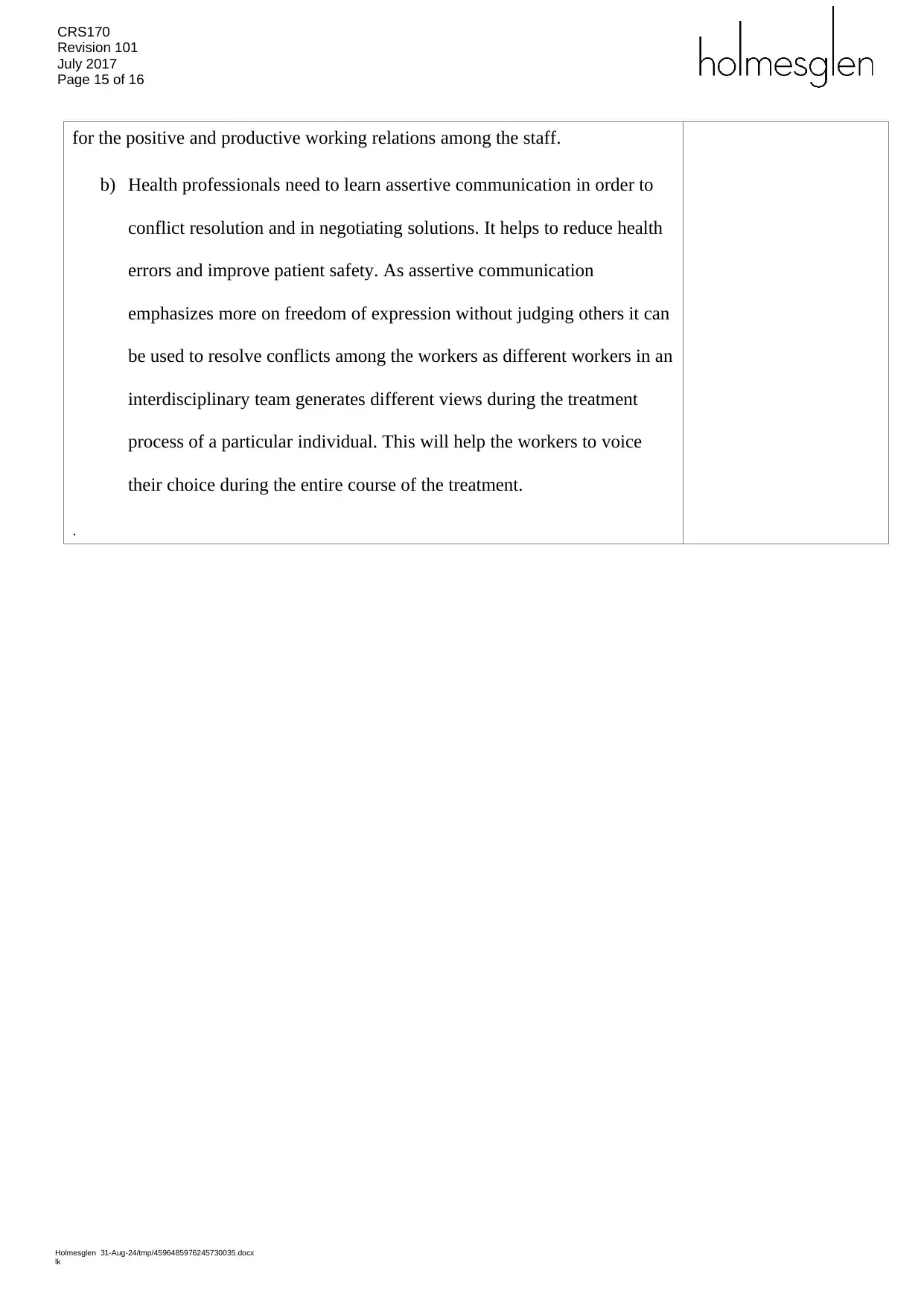
CRS170
Revision 101
July 2017
Page 15 of 16
for the positive and productive working relations among the staff.
b) Health professionals need to learn assertive communication in order to
conflict resolution and in negotiating solutions. It helps to reduce health
errors and improve patient safety. As assertive communication
emphasizes more on freedom of expression without judging others it can
be used to resolve conflicts among the workers as different workers in an
interdisciplinary team generates different views during the treatment
process of a particular individual. This will help the workers to voice
their choice during the entire course of the treatment.
.
Holmesglen 31-Aug-24/tmp/4596485976245730035.docx
lk
Revision 101
July 2017
Page 15 of 16
for the positive and productive working relations among the staff.
b) Health professionals need to learn assertive communication in order to
conflict resolution and in negotiating solutions. It helps to reduce health
errors and improve patient safety. As assertive communication
emphasizes more on freedom of expression without judging others it can
be used to resolve conflicts among the workers as different workers in an
interdisciplinary team generates different views during the treatment
process of a particular individual. This will help the workers to voice
their choice during the entire course of the treatment.
.
Holmesglen 31-Aug-24/tmp/4596485976245730035.docx
lk
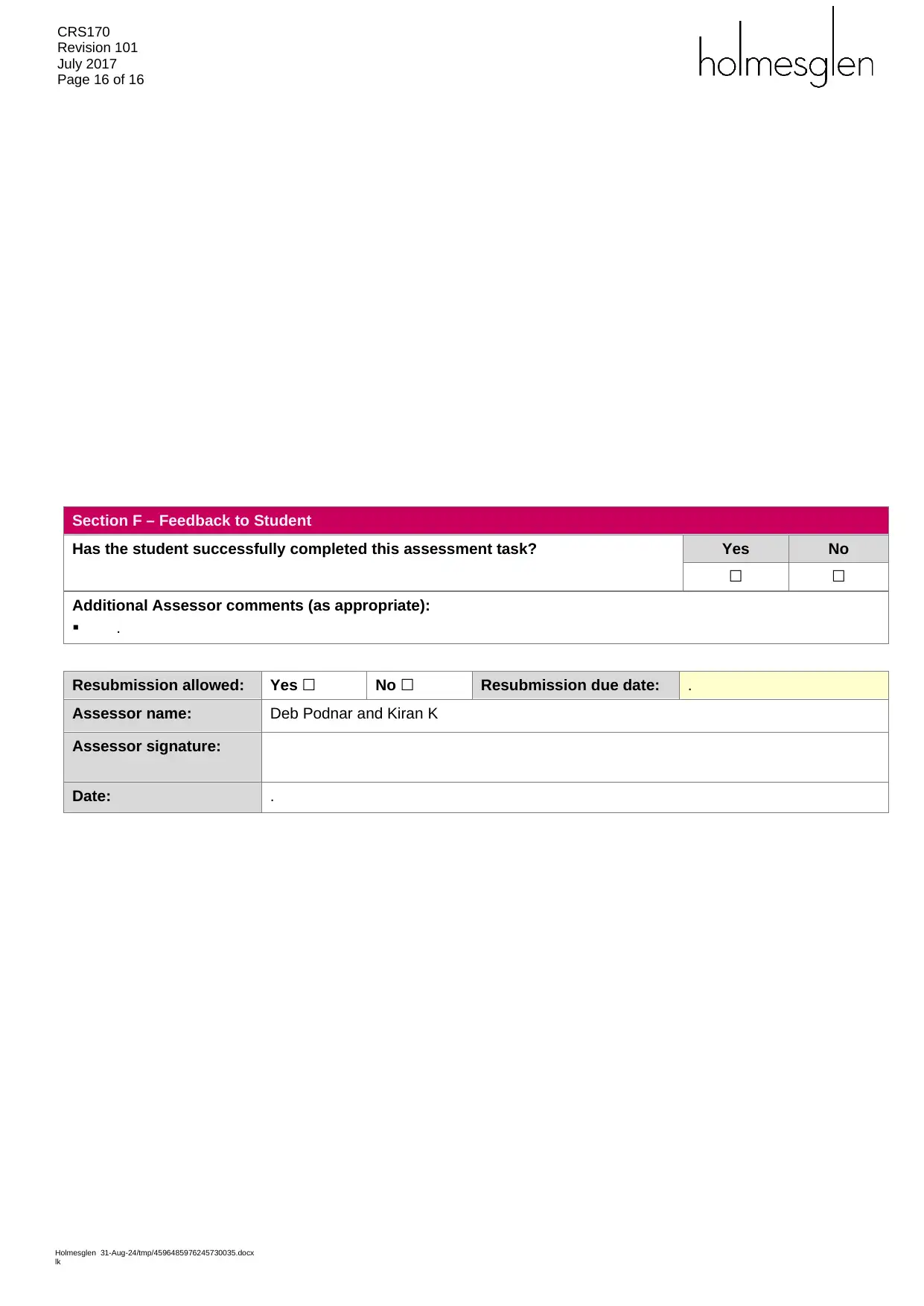
CRS170
Revision 101
July 2017
Page 16 of 16
Section F – Feedback to Student
Has the student successfully completed this assessment task? Yes No
☐ ☐
Additional Assessor comments (as appropriate):
.
Resubmission allowed: Yes ☐ No ☐ Resubmission due date: .
Assessor name: Deb Podnar and Kiran K
Assessor signature:
Date: .
Holmesglen 31-Aug-24/tmp/4596485976245730035.docx
lk
Revision 101
July 2017
Page 16 of 16
Section F – Feedback to Student
Has the student successfully completed this assessment task? Yes No
☐ ☐
Additional Assessor comments (as appropriate):
.
Resubmission allowed: Yes ☐ No ☐ Resubmission due date: .
Assessor name: Deb Podnar and Kiran K
Assessor signature:
Date: .
Holmesglen 31-Aug-24/tmp/4596485976245730035.docx
lk
1 out of 16
Related Documents
Your All-in-One AI-Powered Toolkit for Academic Success.
+13062052269
info@desklib.com
Available 24*7 on WhatsApp / Email
![[object Object]](/_next/static/media/star-bottom.7253800d.svg)
Unlock your academic potential
© 2024 | Zucol Services PVT LTD | All rights reserved.





